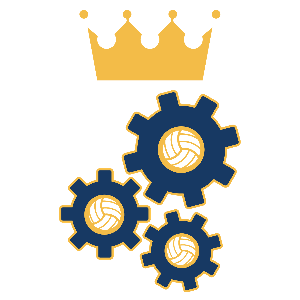Be a Goldfish
You never know where you will find motivation. Sometime it hits you on a walk, or in the middle of the night, often times the answers and motivation come when we stop trying so hard to find them. Today’s post however comes from an unexpected place, the popular soccer comedy Ted Lasso staring Jason Sudeikis as an American soccer coach in England. I have to admit the show was incredibly surprising to me. After watching the first episode, I quickly I binged watched the whole series. It is full of inspiration, comedy, and little lessons. The motivation for this post comes from a scene in which Coach Ted Lasso says to a player on the fictitious premier league club, AFC Richmond, who was struggling. . . . “Sam, Do you know what the happiest animal on earth is?. . . It’s a Goldfish. . .Do you know why?. . . It’s got a 10 second memory. . . Be a Goldfish, Sam.”
I love this quote. In sports we often talk about having a short term memory when things go wrong. Coaches yell shake it off, or on to the next play. When we work with players at Charlotte Soccer Factory in individual or group training we often talk about pushing to a pace, or place that is uncomfortable because in that space is where the growth occurs. The key is as you push that pace you are going to make mistakes. In technical training sessions a lot of time is spent here and talking about how we react to those mistakes. Do you stop, or do you just quickly adjust, get the ball and keep going. Mistakes are inevitable. One of my favorite things to say is that if you didn’t make a mistake we didn’t go quick enough. We ask our players to push their pace to the edge of being almost out of control. It’s in this space that we grow, but it’s also in this space that we sometimes go too quickly. We fall, we make mistakes, we lose the ball. Remember, be a Goldfish.
HIGH PERFORMANCE TRAINING MUST INCLUDE MENTAL TRAINING
The concept of building high performance teams and cultures along with helping to develop high performing individuals is something that I spend a lot of my time on for the work we do at Charlotte Soccer Factory, and First XI Advisors. In a recent conversation with a good friend and mentor, Steven Aldrich of the Oakland Roots, we were discussing my excitement in some new projects. In particular with the work I’ve been doing with Brandon Miller to help current and former athletes discover, pursue and develop opportunities on and off the pitch and building processes and systems that drive success. A big component of the advisory and consulting work Brandon and I are doing is also built around the mental side of the game through a program called Prime Focus Athletes. In my conversation with Steven He made a comment to me that it’s really nice when you are able to help a player develop on the field, but it’s a whole other thing to be able to empower, inspire and impact their lives off of the field too. He’s 100% right. Helping people on and off the pitch is incredibly rewarding, and has a compound effect because often those same people pass on that information and knowledge. I’m hopeful that we can continue to do this and help bring mental training to our CSF family as well.
For Athletes, business leaders, coaches etc. the mental side of development is unfortunately too often ignored. It’s often not something we pay attention to until it is too late, or the opportunity has passed us by. We are taught that at early ages to be “tough,” to fight for what you want, to figure it out on your own, but often never taught how to build resilience, or even what that really means. What we can do on a daily basis to help us build mental strength. To be present, To live in the moment and recognize what is happening. Fortunately today there are more and more high profile athletes, celebrities, etc. speaking up about the realities of depression, stress, and anxiety. This open dialogue is bringing more focus on the mental side of the game albeit sometimes on more negative topics such as depression anxiety, etc. Understanding these feelings, recognizing that they are ok, that they exist, and what we can do when it happens it critical. It’s also critical that we explore the other side, how to build resilience so that it doesn’t, so that we can find the “zone” or “flow” that the greatest athletes, writers, composers, and artist talk about.
MINDFULNESS - IF IT IS GOOD ENOUGH FOR PHIL JACKSON, MAYBE YOU SHOULD TRY IT TOO?
Phil Jackson, the Zen Master as he is often referred to used the concept of mindfulness a key component to his Championship winning teams with the Michael Jordan led Chicago Bulls, as well as with the Kobe and Shaq led Los Angeles Lakers. If you don’t know who any of those people are let’s just say that Phil Jackson is the proud owner of 13 NBA Championship rings, 11 as a Coach and 2 as a player. During his time as the Bulls and Lakers coach he employed a George Mumford, author of the Mindful Athlete, to work with his teams and make mindfulness a key component of everything they did. His book is an interesting read for those looking to dive deeper into this subject.
I’ve talked about Kobe Bryant before and his “Mamba Mentality.” This ability to tune out everything else, to be present in the moment, seeing clearly what you want to do, and reacting to the moment to dominate the game. It is something that Kobe, MJ and countless other athletes have been able to do where others with seemingly the same talent and opportunities have not.
What’s fascinating to me is that there is largely universal agreement that one of the biggest things that separates high performers from everyone else is their mindset and being positive about what they are going to do. They seem to be able to visualize what they want, and then stay laser focused on getting it done when it matters most.
Henry Ford said:
Whether you think you can, or you can’t - you’re right”
The power in these simple ideas goes to show how much your attitude can determine your success. Countless books are written each year talking about visualizing success, being able to paint a picture of what you want, who you want to be etc. They span the spectrum of sports and business, from Think and Grow Rich, to 10 Minute Toughness. The power of training your brain, improving your mental health, and visualizing what, and where you want to go are critical to success.
The brain is incredible. It has control over our body’s both physically and mentally. There are numerous discussions and research however around the brains ability or more precisely its inability to easily tell the difference between real experience, and imaginary or visualizations. Whether you believe this or not, there is certainly at least some agreement that having a clear picture of what you want to achieve whether on the field, in business, or in life. Spending time each day visualizing, and seeing your self doing the skill, being the person you want, having success giving a speech, or living the life you hope to achieve can give you a tremendous advantage when the time comes to take action.
Retraining your mind to be positive vs. our natural inclination to think negatively is not something that can happen over night. We need to make it a part of our daily habits. You must build it into everything you do. No different than if as a soccer player you want to scan the field, or check your shoulders more. Waiting until you are on the soccer field to start, or trying to do it in a game probably isn’t the best solution. Maybe, just maybe you should build it into everything. Walk down the street and start checking your shoulder. So how do we do that with our mental health? How do we start to build resilience, to start to change our brains to see the opportunity and not the failure.
HERE ARE 3 SUGGESTIONS TO GET YOU GOING.
-
Change the words you use. Instead of “I’m really nervous,” try “I’m really excited.” The feelings are often very similar. Pay attention. Your heart rate often gets quicker. Sometimes we start to sweat a little, etc. That happens when you are excited and when you are nervous. So next time you feel those things happen, be present, recognize them and say, “I must be excited about what’s about to happen.”
-
Be a goldfish - As Ted Lasso says “They are the happiest animals on earth.” This idea of 10 second memory works in a lot of ways. As athletes we can’t get to high when things go well, and we can’t get too low when they don’t go our way. Have a short memory, and stay focused on your process, on your system. Be present in the moment and recognize that those ups and downs are all a part of your process, a part of the journey, and all a part of our growth.
-
Check out the course that my friend Brandon Miller (Veteran Soccer player, and Entreprenuer) has built for athletes through Prime Focus Athletes. Join the community, and learn from other professional, amateur, youth, and college athletes as well as from a very well thought out course designed by Brandon Miller.
If you have more questions, or ideas for our community to learn from leave a comment below, or share with us on social media. We are building a community of people looking to grow the game, connect with others, and who believe in the power of sport.
Want to talk more one on one? Email me at [email protected] and let’s chat. If you are local, let’s go for a walk. There are few things more powerful than a good walk and talk with friends.


